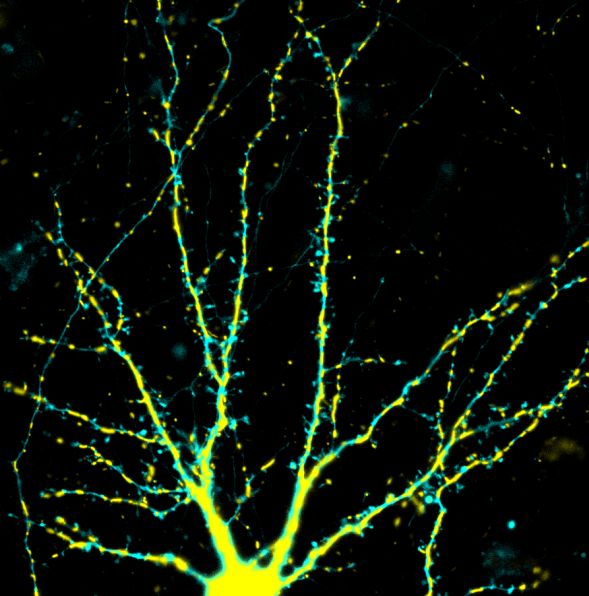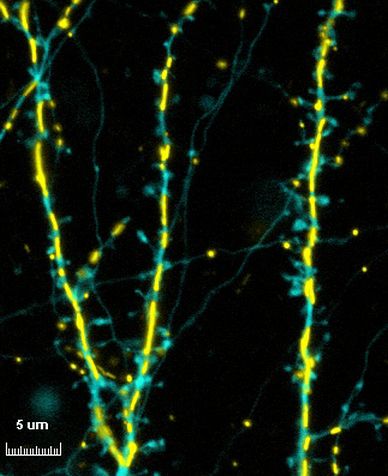Research Funding
We are very grateful for research funding from these agencies.




Research
Themes
Mitochondrial Dynamics
The image of the
mitochondrion presented in most text books is that of a
static, sausage-shaped "power house of the cell".
While
it is true that the primary function of
mitochondria is the generation of ATP to power
most cellular functions, recent
research has revealed that mitochondria are (literally) much more multi-dimensional. Mitochondria are very polymorphic and
dynamic organelles. While some mitochondria do possess a tubular shape, some are much more rounded, and in some cells
mitochondria form a continuous web-like network. Perhaps one of the more surprising and interesting aspects of mitochondria
is that they are dynamic organelles: they undergo fusion, fission, and they are rapidly transported throughout the cell. The term
“Mitochondrial Homeostasis” has been used to describe the amalgam of all the processes which influence the number, shape
and position of mitochondria. These include mitochondrial biogenesis, fission, fusion, transport and degradation. The cellular
control, mechanics and in some cases even the significance of these processes are poorly understood. To study these processes,
we employ targeted expression of fluorescent proteins which allows for examination of individual mitochondria within cells using
fluorescence microscopy (see micrographs below).
cell death. One of the major themes of my research is the role of mitochondria in cell death, examining modulation of intracellular
calcium, disruption of ATP generation, and release of factors from mitochondria which participate in cell death mechanisms.
The impact of the physiologic (ATP generation & calcium buffering) and pathophysiologic (release of pro-apoptotic proteins and
reactive oxygen species) functions of mitochondria may be critically affected by changes in mitochondrial homeostasis. Therefore
my guiding hypothesis is that normal biogenesis, fission, fusion, trafficking and degradation of mitochondria are essential for
neuronal function and disruption of mitochondrial homeostasis is a factor in neuronal injury mechanisms.
research has revealed that mitochondria are (literally) much more multi-dimensional. Mitochondria are very polymorphic and
dynamic organelles. While some mitochondria do possess a tubular shape, some are much more rounded, and in some cells
mitochondria form a continuous web-like network. Perhaps one of the more surprising and interesting aspects of mitochondria
is that they are dynamic organelles: they undergo fusion, fission, and they are rapidly transported throughout the cell. The term
“Mitochondrial Homeostasis” has been used to describe the amalgam of all the processes which influence the number, shape
and position of mitochondria. These include mitochondrial biogenesis, fission, fusion, transport and degradation. The cellular
control, mechanics and in some cases even the significance of these processes are poorly understood. To study these processes,
we employ targeted expression of fluorescent proteins which allows for examination of individual mitochondria within cells using
fluorescence microscopy (see micrographs below).
Mitochondria and Neuronal Injury
The dysfunction of mitochondria has been implicated in many progressive neurodegenerative disorders and more acute ischemiccell death. One of the major themes of my research is the role of mitochondria in cell death, examining modulation of intracellular
calcium, disruption of ATP generation, and release of factors from mitochondria which participate in cell death mechanisms.
The impact of the physiologic (ATP generation & calcium buffering) and pathophysiologic (release of pro-apoptotic proteins and
reactive oxygen species) functions of mitochondria may be critically affected by changes in mitochondrial homeostasis. Therefore
my guiding hypothesis is that normal biogenesis, fission, fusion, trafficking and degradation of mitochondria are essential for
neuronal function and disruption of mitochondrial homeostasis is a factor in neuronal injury mechanisms.
Below: Fluorescence
micrographs (low and high magnification) of a neuron
co-transfected with
mitochondrially-targeted yellow fluorescent protein and cytoplasmic cyan fluorescent protein.
mitochondrially-targeted yellow fluorescent protein and cytoplasmic cyan fluorescent protein.



